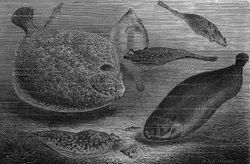| Flatfish | ||||||||
|---|---|---|---|---|---|---|---|---|

19th c. engraving depicting several types
of flatfish
|
||||||||
| Scientific classification | ||||||||
|
||||||||
|
Suborder Psettodoidei Psettodidae Suborder Pleuronectoidei Citharidae Scophthalmidae (turbots) Bothidae (lefteye flounders) Pleuronectidae (righteye flounders) Paralichthyidae (large-tooth flounders) Achiropsettidae (southern flounders) Samaridae Suborder Soleoidei Soleidae (soles) Achiridae (American soles) Cynoglossidae (tonguefishes) |
The flatfish are an order (Pleuronectiformes) of ray-finned fish, also called the Heterosomata, sometimes classified as a suborder of Perciformes. The name means "side-swimmers" in Greek. In many species both eyes lie on one side of the head, one or the other migrating through and around the head during development. Some species face their "left" side upward, some face their "right" side upward, and others face either side upward. The other distinguishing features of the order are the presence of protrusible eyes, another adaptation to living on the sea-bed (benthos), and the extension of the dorsal fin onto the head.
Many important food fish are in this order, including the flounders, soles, turbot, plaice, and halibut. There are more than 400 species of this order. Some flatfish can camouflage themselves on the ocean floor.
Flatfish have been cited as dramatic examples of evolutionary adaptation. For example, Richard Dawkins in The Blind Watchmaker, explains the flatfish's evolutionary history as:
... bony fish as a rule have a marked tendency to be flattened in a vertical direction.... It was natural, therefore, that when the ancestors of [flatfish] took to the sea bottom, they should have lain on one side.... But this raised the problem that one eye was always looking down into the sand and was effectively useless. In evolution this problem was solved by the lower eye 'moving' round to the upper side.
The development of flatfish is thus considered to recapitulate their evolutionary history.
The asymmetric geometry of flatfish has been likened to the cubist paintings of Pablo Picasso, and is often perceived as being "imperfect", "grotesque", "strange", etc. It is likely that the asymmetry contributes to their survival by helping to disguise them on the ocean floor.




 216.73.216.190
216.73.216.190 User Stats:
User Stats:
 Today: 0
Today: 0 Yesterday: 0
Yesterday: 0 This Month: 0
This Month: 0 This Year: 0
This Year: 0 Total Users: 117
Total Users: 117 New Members:
New Members:
 216.73.xxx.xxx
216.73.xxx.xxx
 Server Time:
Server Time: